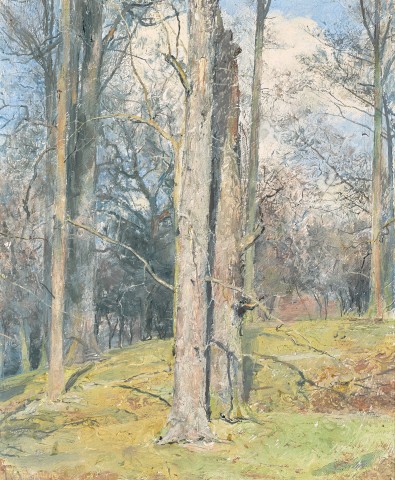WINTER, ENGLAND, c.1920
TOM ROBERTS
oil on canvas on plywood
43.5 x 34.5 cm
signed lower left: Tom Roberts
bears framer’s label verso: Dicksee & Co., Bradford, 1911
Mr and Mrs Oswald Syme, Melbourne, 1920
Thence by descent
Private collection, Melbourne
Christie’s, Melbourne, 28 April 1992, lot 159 (as ‘Autumn, England’)
Company collection, Sydney
Private collection, Sydney
Possibly: Souvenir Exhibition of Paintings by Tom Roberts, Athenaeum Hall, Melbourne, 1920, cat. 11 (as ‘Ham Common’)
Tom Roberts: Retrospective, Art Gallery of South Australia, Adelaide, 4 October – 17 November 1996; Tasmanian Museum and Art Gallery, Hobart, 29 November 1996 – 27 January 1997; National Gallery of Victoria, Melbourne, 11 February – 6 April 1997; Art Gallery of New South Wales, Sydney, 18 April – 1 June 1997; Art Gallery of Western Australia, Perth, 11 June – 27 July 1997, cat. 74 (label attached verso)
Topliss, H., Tom Roberts 1856 – 1931: A Catalogue Raisonné, Oxford University Press, Melbourne, 1985, cat. 512, vol. I, p. 197; vol. II, pl. 209 (illus., as ‘Autumn, England’)
Radford, R., Tom Roberts: Retrospective, Art Gallery of South Australia, Adelaide, 1996, p. 213 (illus., as ‘Autumn, England’)
The Copse in Winter, c.1910, oil on canvas on plywood, 33.5 x 43.5 cm, private collection, illus., in Gray, A., Tom Roberts, Australian National Gallery, Canberra, 2015, cat. 109, pp. 276, 277
By August 1909, Tom Roberts and his family had moved to the London suburb of Hampstead Garden, within easy reach of Hampstead Heath and all the landscape opportunities it offered. Winter, England, c.1911 appears to be one so inspired. This is supported by other paintings related in subject, style and date, particularly The Copse in Winter, c.1910 (private collection). In her catalogue book to the National Gallery of Australia’s Tom Roberts exhibition of 2015, Anne Gray comments on its ‘bare skeletons of trees scoring the cloudy blue sky’ and the ‘whispery atmosphere, suggesting perhaps a touch of wind among the stiffened branches’.1 Open skies dominate The Copse in Winter, whereas Winter, England is enclosed, dominated by grey trees, pale yellows and blues. Yet, both paintings are filled with the atmosphere of winter, sharing cool sunlight and skeletal branches of trees stripped of their leaves. Moreover, a framer’s label on the verso of Winter, England, c.1911 carries both Robert’s new address, ‘Bigwood Road, Hampstead Garden Suburb’ and the date ‘1911’.
Further support for the identification of Winter, England as a Hampstead Heath subject comes from the Roberts’ scholars Virginia Spate and Helen Topliss. Topliss, in her catalogue raisonné of Roberts works, lists our painting, (catalogue number 512), as Autumn England of c.1920. She also noted that Spate suggested it was ‘Supposedly purchased by the original owner at the Athenaeum in 1920 – the present title probably given to it by the owners as it doesn’t correspond with anything in the catalogue of 1920.’ She added: ‘It could possibly be Ham Common, No. 11’.2
Harrow on the Hill, c.1910-12 (Art Gallery of New South Wales, Sydney) is another significant work related to this engaging group of English landscapes. Here, Anne Gray noted the influence of John Constable, renowned for his views of Hampstead, adding ‘it is possible that Constable’s Hampstead landscapes and cloud studies inspired Roberts to paint this view’.3 For Roberts, the previous years had been a time of renewal and enrichment. From the vast Turneresque skies and seas of Storm at Sea, 1907 and the Whistlerian tones and mists of Thames Barges, c.1909 (both in the collection of the Art Gallery of New South Wales), together with Constable’s arching heavens of Harrow on the Hill, c.1910-12, Roberts developed his distinctive English style of painting.
Roberts’ Australian and English landscapes show a great love of trees, honouring their nobility and exploiting their compositional value. This is reflected in many paintings, especially in titles such as Joy o’ Gums c.1920s and A Queen of Gums, 1926 (private collection). Trunks upright, often close to the picture plane, as in Winter, England, c.1911, dominate. The classic balance between vertical and horizontal was a feature of Roberts’ work from Bailed Up, 1895-1927 (Art Gallery of New South Wales, Sydney), through Winter, England, c.1911, to Sherbrooke Forest, 1924 (Art Gallery of New South Wales, Sydney). Although dubbed ‘the father of Australian landscape painting’,4 Roberts spent a large part of his creative life in England, the country of his birth. Sharing his lifetime and artistic achievements between England and Australia, each greatly enriched the other.
1. Gray, A., Tom Roberts, Australian National Gallery, Canberra, 2015, p. 276
2. Quoted in Topliss, H., op. cit., p. 197, cat. 512. See under ‘Literature’ for details of the 1920 catalogue.
3. Gray, A., op. cit., p. 279
4. Croll, R.H., Tom Roberts: Father of Australian Landscape Painting, Robertson & Mullens, Melbourne, 1935
DAVID THOMAS
